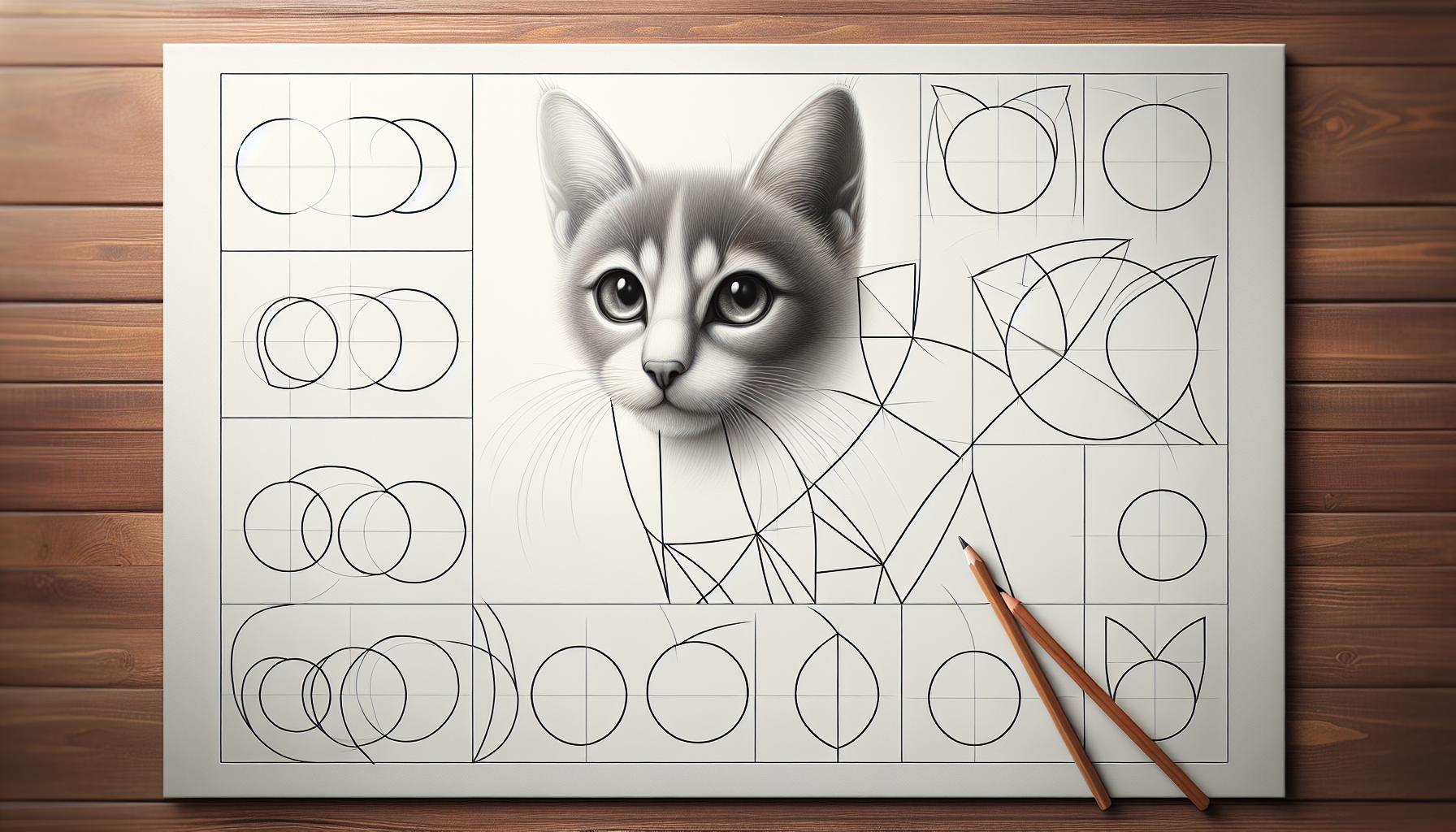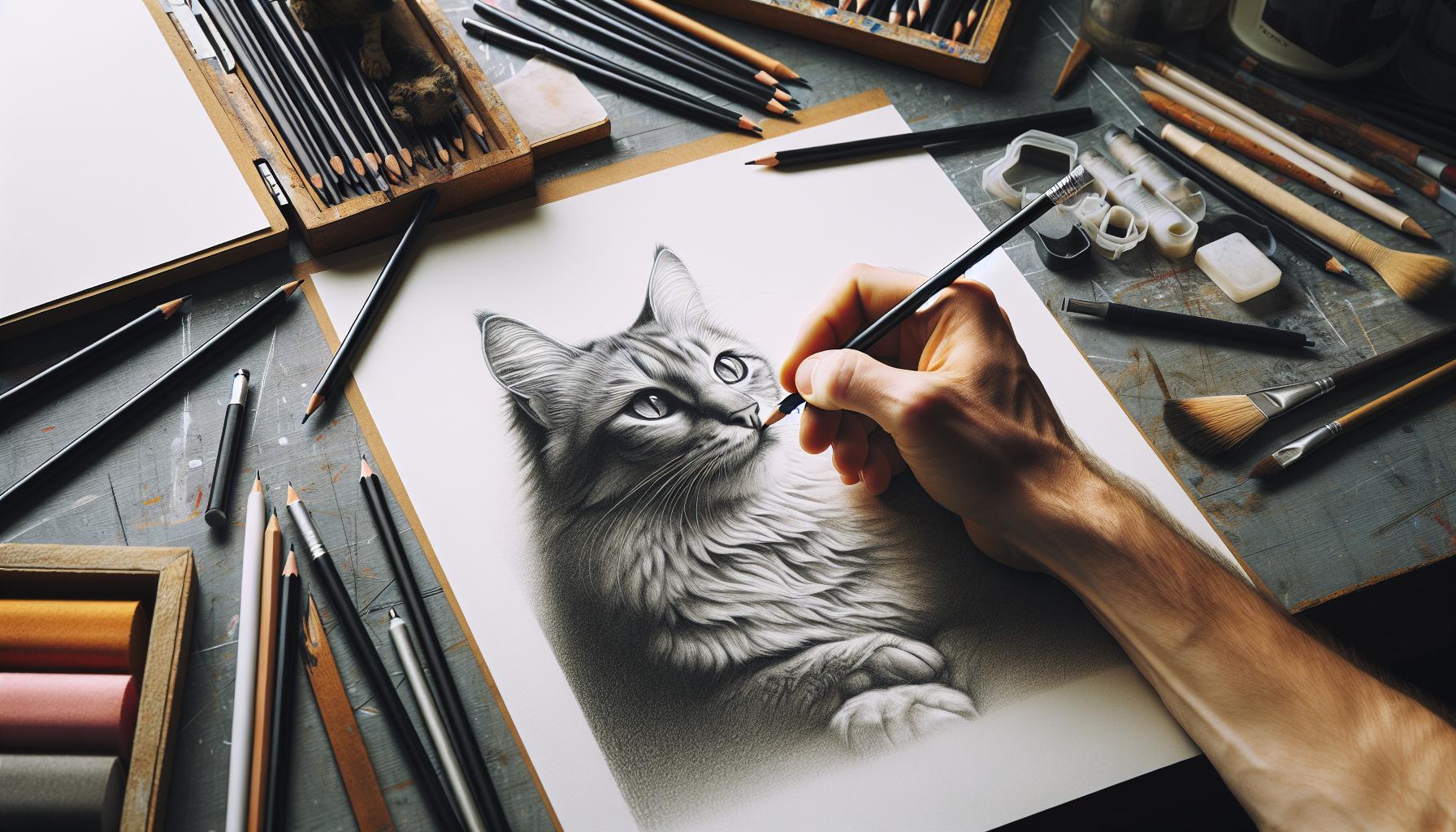Drawing cats has never been more delightful and achievable than with the simple “gato dibujo” technique. This beginner-friendly approach transforms the art of sketching felines into an enjoyable experience that anyone can master with just a few basic strokes.
From playful kittens to majestic adult cats, this straightforward drawing method breaks down complex feline features into easy-to-follow geometric shapes. Artists and enthusiasts alike will discover how basic circles, triangles and curved lines come together to create expressive cat faces that capture the unmistakable charm of our furry friends. Whether you’re an aspiring artist or simply looking for a fun creative outlet, learning to draw cats using this accessible technique will have you sketching adorable felines in no time.
Facil:_8-eunsl6sy= Gato Dibujo
- Create the Basic Head Shape
- Draw a large circle for the head
- Add two smaller triangular ears on top
- Connect the shapes with smooth curves
- Place Facial Guidelines
- Mark the center line vertically through the face
- Add a horizontal line across the middle
- Plot two small circles for eye placement
- Position the nose point below the eyes
- Define Key Features
- Sketch almond-shaped eyes on the guidelines
- Draw a small triangular nose
- Create curved whisker pads on each side
- Add six whiskers extending outward
- Shape the Ears
- Fill in the triangular ear outline
- Round the ear tips slightly
- Add inner ear details with curved lines
- Create small tufts of fur inside
- Add Final Details
- Draw small curved lines for fur texture
- Outline the mouth with a gentle curve
- Darken the pupils inside the eyes
- Blend the neck into the head shape
Each step builds upon the previous one creating a recognizable cat face. The process uses basic geometric shapes as building blocks making it accessible for beginners. The method emphasizes proportion placement ensuring features align naturally. Artists can customize details like ear size whisker length fur texture to create unique expressions.
| Feature | Size Ratio | Position |
|---|---|---|
| Head Circle | 1:1 | Center |
| Eyes | 1/4 of head | Upper third |
| Ears | 1/3 of head | Top corners |
| Nose | 1/8 of head | Below eyes |
Basic Shapes for Your Cat Drawing

The foundation of a cat drawing starts with simple geometric shapes that combine to create recognizable feline features. These basic forms serve as building blocks for a more detailed illustration.
Creating the Head and Body Outline
Starting with a large circle forms the cat’s head base. A smaller oval overlaps the bottom portion of the circle to create the muzzle area. Two triangular shapes extend from the top of the head circle to form the ears. The body emerges from an elongated oval that connects to the head, while four smaller cylinders represent the legs. A long curved line extends from the body’s back to create the tail. These primary shapes establish correct proportions for the cat’s overall structure.
Adding Facial Features
The cat’s distinctive facial features emerge from strategic placement within the head circle. Two almond shapes positioned in the upper half of the face circle create the eyes. A small triangle centered below the eyes forms the nose. Three curved lines on each side of the nose represent the whisker pads. Six to eight long straight lines extend outward from each whisker pad. The mouth appears as a simple curved line below the nose. These elements combine to capture the characteristic feline expression while maintaining proper spatial relationships.
Essential Drawing Techniques

Drawing cats requires mastering fundamental techniques that enhance the overall quality of the artwork. These techniques focus on creating clean lines and adding depth through strategic shading.
Line Work Tips
Light pencil strokes create the initial sketch outline for a cat’s basic shape. Starting with loose, flowing lines helps establish natural curves for the body posture, tail, and legs. Single, confident strokes produce cleaner lines than multiple short, hesitant marks. Varying line weight adds dimension, with thicker lines defining main contours and thinner lines detailing fur texture. A mechanical pencil (0.5mm) offers precise control for fine details like whiskers and eye highlights. Erasing guidelines after finalizing the main features keeps the drawing clean and professional.
Shading Methods
Strategic shading creates depth and volume in cat drawings through distinct techniques. Cross-hatching adds texture to fur areas using intersecting lines at 45-degree angles. Circular motions with a soft pencil create smooth transitions in shadowed areas beneath the chin and along the body. Layering light strokes builds gradual darkness, maintaining control over tone intensity. Directional shading follows the natural flow of fur growth patterns. The lightest values highlight facial features, while darker tones define muscle structure and form shadows under the paws. Blending tools smooth transitions between light and dark areas without smudging essential details.
Common Mistakes to Avoid

Incorrect proportions create unrealistic cat drawings when artists make the head too small or large relative to the body. Drawing eyes at different heights or sizes breaks facial symmetry, disrupting the natural feline appearance. Positioning ears directly on top of the head instead of slightly to the sides produces an artificial look.
Oversimplified whiskers diminish the cat’s character, particularly when drawn as straight lines without natural curve patterns. Drawing stiff legs without proper joint placement creates rigid postures that lack the graceful feline movement. Flat shading without considering light sources results in two-dimensional artwork lacking depth.
Here are key errors to watch for:
- Placing facial features too close together
- Drawing rigid straight whiskers instead of curved ones
- Making the nose too large or detailed
- Creating perfectly circular eyes without almond shapes
- Adding too many fur details that overwhelm the drawing
- Forgetting to include whisker pads
- Drawing ears identical in size or angle
Advanced artists avoid these technical issues:
- Inconsistent line weight throughout the drawing
- Harsh transitions between light and shadow areas
- Misaligned body proportions from rushed sketching
- Symmetrical facial features lacking natural variation
- Over-defined muscle details that appear unnatural
| Feature | Correct Proportion | Common Error |
|---|---|---|
| Head size | 1/3 of body length | Too large/small |
| Eye spacing | 1 eye width apart | Too close/far |
| Ear height | 1/2 head height | Too tall/short |
| Whisker length | 2x head width | Too short/rigid |
Adding Personal Style to Your Cat Drawing
Unique artistic elements transform basic cat sketches into personalized masterpieces. Artists express individuality through varied eye shapes, from wide-set almond shapes to narrow slits that capture different moods. Fur textures range from short strokes for sleek coats to longer sweeping lines for fluffy cats like Maine Coons or Persians.
Customization options include:
- Creating distinctive markings (tabby stripes, calico patches, tuxedo patterns)
- Adjusting ear sizes to reflect different breeds (pointed Siamese ears, rounded British Shorthair ears)
- Varying whisker patterns (long sweeping curves, short straight lines)
- Adding accessories (collars, bows, bandanas)
Facial expressions convey personality through:
- Eye placement and size
- Whisker pad curvature
- Mouth shape variations
- Ear positioning
Different shading techniques highlight unique characteristics:
- Cross-hatching for defined fur patterns
- Stippling for texture variety
- Smooth blending for subtle transitions
- Directional strokes for fur flow
Color application methods enhance individuality:
- Layered pencil strokes for depth
- Watercolor washes for soft effects
- Marker highlights for bold contrast
- Digital brushwork for smooth gradients
Breed-specific features incorporate:
- Persian flat faces
- Siamese angular profiles
- Russian Blue rounded contours
- Maine Coon square muzzles
Each element combines to create distinct feline personalities while maintaining anatomical accuracy. Artists develop signature styles by experimenting with these variations in their cat drawings.
The “gato dibujo” technique opens up a world of artistic possibilities for anyone interested in drawing cats. By following these structured steps and maintaining proper proportions artists can create captivating feline portraits that capture both realism and personality.
Whether someone’s drawing their first cat or refining their artistic skills this method provides a solid foundation for success. With practice patience and attention to detail artists will find themselves creating increasingly sophisticated and expressive cat illustrations that bring joy to both creator and viewer alike.
The beauty of this approach lies in its flexibility – allowing artists to develop their unique style while staying true to fundamental feline features. As skills grow these basic techniques can be adapted to create everything from simple sketches to complex detailed portraits.

